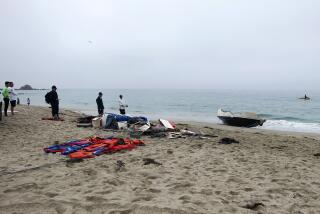Laguna Hams Forge Critical Link to Couple Adrift in Disabled Boat
- Share via
Gregg Howe, taking a late lunch break from his auto electrical repair business in Laguna Beach, sat before his amateur radio gear and broadcast a casual “CQ/DX”--radio jargon for “is anyone out there?”
Back came the static-ridden voice of Susan Thomas, a voice the U.S. Coast Guard and amateur radio operators had been trying to raise for the two days since she had broadcast a distress signal from her dismasted 29-foot sailboat somewhere in the Pacific Ocean.
For the next 28 hours, Howe stayed by his radio equipment, acting as bridge between the Coast Guard rescue coordination center in Long Beach and the boat, Grass Matinee, adrift in heavy swells about 700 miles south of San Diego.
On Sunday, four days after the original distress call, the boat, with Susan Thomas and her husband, Patrick, aboard, was being towed toward San Diego by the Coast Guard cutter Venturous. They were expected to reach San Diego on Thursday.
Howe wasn’t the only amateur radio operator or “ham” to help rescue the Thomases. A Coast Guard spokesman said Dean Slater, also of Laguna Beach, helped relay information to the maritime force from hams in Tahiti, where the Thomases’ original distress call was heard.
“We routinely work with ham radio operators, and they’re extremely helpful,” said Coast Guard Lt. Mike Parks. Although the Coast Guard prefers that sailors use the recognized maritime radio channels, “a lot of long-range oceanic sailors do, in fact, use ham radios. . . . At times, it can be as effective, sometimes more effective.” It all depends on atmospheric conditions, he said.
Slater, 36, an air-conditioning estimator who does most of his work at home, was on the air Wednesday afternoon when a ham radio operator in Tahiti broke into his conversation and asked for help.
The Thomases’ distress call had been picked up in Tahiti, and word had been passed on to the Coast Guard. The Tahitian ham wanted Slater to call the Coast Guard in Long Beach with additional information.
Slater made the call, and the Coast Guard “wanted to know everything,” Slater said. “They said to get back and get every little detail I could. I spent all night long going back and forth.”
The information provided by Slater those first hours “was very helpful,” Parks said Sunday. The Coast Guard was preparing to search a large area but had been unable to contact the boat to home in on its location.
But as time passed, “I was kind of scared,” Slater recalled. “We tried to make contact with the boat again, and no one could for two days.
“I was kind of in shock--almost like it was a dream and not reality. You hear about this sort of thing happening, but you never get involved in it.”
Without Trying
On Friday afternoon, Howe, 28, unaware of efforts to contact the boat, succeeded without even trying. He just turned on his radio while he sat down to eat lunch.
“This was an out-of-band channel; it’s not legal in the United States,” Howe said. “Once, the Navy did tune in on the frequency, but I was still the only one to keep and maintain contact. I’ve got a very exotic homemade antenna with a bird’s-eye view of the Pacific Ocean and some very sophisticated equipment.”
Howe said the situation did not sound particularly serious at first. Susan Thomas wanted him only to telephone her mother in Washington “and let her know that everything’s OK.”
Howe did, but in about 15 minutes he received a telephone call from the Coast Guard in Long Beach, apparently alerted by Thomas’ mother. “As soon as the Coast Guard called me, I got really excited,” Howe said. “Coming to me for this kind of information--I was really jazzed about that.”
Howe said that from 2:30 p.m. Friday until 6:30 p.m. Saturday, when the Coast Guard cutter linked up with Grass Matinee, he remained at his radio, maintaining nearly continuous communications with the boat. Auto repair work at his shop came to a standstill, but customers seemed content to sit around and listen.
Set Off From France
Howe said Thomas told him that she and her husband originally had set off from France in 1983 and had been taking a slow cruise toward the state of Washington. The boat’s sails had been stripped away and its mast broken during heavy weather Wednesday, but the couple had rigged a makeshift sail and seemed content to drift eastward toward the South Pacific islands. They had 70 gallons of fresh water and a two-month supply of food, Howe said.
“We were able to communicate, and that greatly enhanced our ability to find the vessel,” Parks said Sunday. “Navy aircraft made contact Saturday afternoon at 4 p.m. Pacific time, right in the center of the search area.”
Would the boat have been found without the amateurs’ help? “Hopefully,” Parks said.
More to Read
Sign up for Essential California
The most important California stories and recommendations in your inbox every morning.
You may occasionally receive promotional content from the Los Angeles Times.













